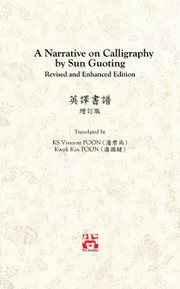Galleries and Translations > Models of Masterpieces > Modelling and English Translation of Sun Guoting's "A Narrative on Calligraphy" 孫過庭 《書譜》之臨習與英譯
Modelling and English Translation of Sun Guoting's "A Narrative on Calligraphy"
(Part VII)
by Kwan Sheung Vincent POON (潘君尚)
Dec. 25, 2017
Published on www.vincentpoon.com, Toronto
A. Modelling (by KS Vincent POON)
B. Historical Information
Please see Part I
Readers are strongly encouraged to read the blue numerical footnotes below to gain a better understanding of the original Chinese text and to review some major errors in the translations made by others.
English Translation
Original Chinese Text
Alas, what is understood in the mind can be difficult to express completely in words; what can be communicated through words can still be hard to describe with ink and paper (ie. in written texts).
150. 夫心之所達,不易盡於名言;言之所通,尚難形於紙墨。
151. 粗可髣髴其狀,綱紀其辭 。
152. 冀酌希夷,取會佳境。闕而未逮,請俟將來。
153. 今撰執、使、用、轉之由,以祛未悟:
Zhi (執) refers to how one can hold a brush, such as holding it higher away or lower towards (深淺長短,133) the tip of a brush, and so on;
154. 執謂深淺長短之類是也;
Shi (使) refers to how one moves a brush, such as dragging or pulling it (牽掣) horizontally or vertically (縱橫), and so on;
155. 使謂縱橫牽掣之類是也;
Zhuan(轉) refers to the concerted movements of turning a brush to pen brushstrokes that are in the forms of hooks(鉤), rings(鐶), twists(盤), turns(紆), and so on;
156. 轉謂鉤鐶盤紆之類是也;
Yong (用) refers to the overall structure of a character, such as the arrangements of dots and lines (點畫), the symmetries within a character (向背,134), and so on.
157. 用謂點畫向背之類是也。
Further, I shall collect the many principles of calligraphy (會其數法, 135) and bring them together as a path for one to pursue;
158. 方復會其數法,歸於一途;
I will compile and list the various individuals who are adept at calligraphy as well as their intricate wonders.
159. 編列眾工,錯綜羣妙。
I also aim to point out aspects that were not mentioned by venerable predecessors so as to enlighten future learners in regards to the well-established principles of calligraphy.
160. 舉前賢之未及,啟後學於成規。
Moreover, I shall examine and investigate the root and origin of the art as well as analyze its different branches and schools.
161. 窺其根源,析其枝派。
It is my utmost intention (貴,136) to make the language simple and to present rich arguments so that my writings reflect exactly what I comprehend in my mind;
162. 貴使文約理贍,迹顯心通;
when one reads the scroll (ie. this narrative), one will understand with ease and so not be obscured when one writes calligraphy.
163. 披卷可明,下筆無滯。
As for bizarre assertions and odd theories, they will not be detailed here.
164. 詭詞異說,非所詳焉。
Nonetheless, the present narrative aims to benefit all learners.
165. 然今之所陳,務裨學者。
Every piece of calligraphy written by Youjun (Wang Xizhi) is widely known (習,137) and praised (稱,138) in our times(代,139), and so his outstanding artistry certainly qualifies him to be regarded as a role model to follow and a venerable grand master of calligraphy, and hence drawing from his accomplished works (立,140) as a direction for one’s learning ambitions is surely appropriate. Not only was he adept at simultaneously expressing the unadorned styles of the past and the elegant fashions of the present, he was also able to showcase his deep emotions with manners that are agreeable and harmonious.
166. 但右軍之書,代多稱習,良可據為宗匠,取立指歸。豈唯會古通今,亦乃情深調合。
As a result, his works are increasingly being modeled (摹) and printed (via ink rubbings on carved wood or stone, 搨,141) by the day, and the number of students studying his calligraphy is growing year by year. The various renowned (著名,142) models and prints, regardless of their rankings in quality(先後,143), are mostly made in accordance to his long lost handwritten originals (多從散落,144). Indeed, his style of calligraphy is singularly conveyed throughout generations; isn’t that the result of the wide and intensive modelling and printing of his works (非其効歟,145)?
167. 致使摹搨日廣,研習歲滋。先後著名,多從散落。歷代孤紹,非其効歟?
Now, I shall attempt to outline his personal artistic evolution (由,146) and then narrate some of my own opinions.
168. 試言其由,略陳數意。
His works such as (止如,147) Narration on Yue Yi (《樂毅論》), The Yellow Court Classic (《黃庭經》), Commentaries on the Portrait of Dongfang Shuo (《東方朔畫讚》), Admonitions to the Emperor from the Imperial Mentor (《太師箴》), Preamble to the Collection of Poems written in the Orchard Pavilion (《蘭亭集序》, also commonly known as Lanting Xu ), and The Statement of Pledge 《告誓文》are all retained by the public in our times (代俗,148), and they are certainly the top and most marvelous among standard and semi-cursive script calligraphies.
169. 止如《樂毅論》、《黃庭經》、《東方朔畫讚》、《太師箴》、《蘭亭集序》、《告誓文》,斯並代俗所傳, 真行絕致者也。
FOR LINES 170-179,
PLEASE PURCHASE THE REVISED AND ENHANCED EDITION WITH FOOTNOTES AND BIBLIOGRAPHY:
170. 寫《樂毅》則情多怫鬱;書《畫讚》則意涉瓌奇;
171. 《黃庭經》則怡懌虛無;《太師箴》又縱橫爭折。
172. 暨乎蘭亭興集,思逸神超;
173.私門誡誓,情拘志慘。
174. 所謂涉樂方咲,言哀已歎。
175. 豈惟駐想流波,將貽嘽喛之奏;
176. 馳神睢渙,方思藻繪之文。
177. 雖其目擊道存,尚或心迷義舛。莫不強名為體,共習分區。
178. 豈知情動形言,取會風騷之意;
179. 陽舒陰慘,本乎天地之心。既失其情 ,理乖其實。原夫所致,安有體哉?!
FOR FURTHER TRANSLATION, FOOTNOTES, AND
ELABORATIONS
PLEASE SEE :
 A Narrative on Calligraphy by Sun Guoting Revised and Enchanced Edition 英譯書譜 增訂版
A Narrative on Calligraphy by Sun Guoting Revised and Enchanced Edition 英譯書譜 增訂版Translated by KS Vincent POON and Kwok Kin POON (Mar. 2019)
ISBN 978-1-989485-10-1
A Narrative on Calligraphy (Shu Pu, 書譜) was written in 687AD by the renowned Tang dynasty calligrapher Sun Guoting (孫過庭) of the seventh century and is regarded to be one of the most important narratives in examining the traditional art of Chinese calligraphy. Yet, there is currently no satisfactory English translation of it. This book provides readers an accurate, annotated, line-by-line, consistent and comprehensive English translation of A Narrative on Calligraphy. Furthermore, various major and fundamental mistakes found in the two previous English translations by Chang & Frankel and De Laurentis are detailed and discussed.
This book is the revised and enhanced version of the previous book and delivers an even more precise translation with 20 titled thematic paragraphs that is based on Dr. Kwok Kin POON’s The Vernacular Chinese Translation of Sun Guoting’s A Narrative on Calligraphy (孫過庭書譜白話對譯. Toronto: The SenSeis, Feb. 2019).
WorldCat/Library: [WorldCat] [Oxford U] [U of T] [Harvard U] [Columbia U] [HKU] [CUHK] [Kyoto U] [National Taiwan U]
END OF PART VII (Dec. 25, 2017)